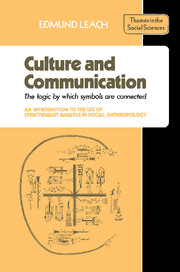 Culture and Communication
Culture and Communication Book contents
- Frontmatter
- Contents
- Culture and communication: the logic by which symbols are connected
- Introduction
- 1 Empiricists and rationalists: economic transactions and acts of communication
- 2 Problems of terminology
- 3 Objects, sense-images, concepts
- 4 Signals and indices
- 5 Transformations
- 6 Theories of magic and sorcery
- 7 The symbolic ordering of a man-made world: boundaries of social space and time
- 8 The material representation of abstract ideas: ritual condensation
- 9 Orchestral performance as a metaphor for ritual sequence
- 10 The physiological basis of sign/symbol sets
- 11 Mapping: time and space as reciprocal representations
- 12 Rank order and orientation
- 13 Examples of binary coding
- 14 Mating prescriptions and proscriptions
- 15 Logic and mytho-logic
- 16 Basic cosmology
- 17 Rites of transition (rites de passage)
- 18 The logic of sacrifice
- 19 Conclusion
- Bibliography
- Index
9 - Orchestral performance as a metaphor for ritual sequence
Published online by Cambridge University Press: 05 June 2012
- Frontmatter
- Contents
- Culture and communication: the logic by which symbols are connected
- Introduction
- 1 Empiricists and rationalists: economic transactions and acts of communication
- 2 Problems of terminology
- 3 Objects, sense-images, concepts
- 4 Signals and indices
- 5 Transformations
- 6 Theories of magic and sorcery
- 7 The symbolic ordering of a man-made world: boundaries of social space and time
- 8 The material representation of abstract ideas: ritual condensation
- 9 Orchestral performance as a metaphor for ritual sequence
- 10 The physiological basis of sign/symbol sets
- 11 Mapping: time and space as reciprocal representations
- 12 Rank order and orientation
- 13 Examples of binary coding
- 14 Mating prescriptions and proscriptions
- 15 Logic and mytho-logic
- 16 Basic cosmology
- 17 Rites of transition (rites de passage)
- 18 The logic of sacrifice
- 19 Conclusion
- Bibliography
- Index
Summary
Lévi-Strauss, who has contributed so much to our understanding of meta-linguistic modes of communication, constantly refers to the structural similarity between myth and music. In a celebrated and characteristically opaque statement he has declared that ‘the myth and the musical work are like conductors of an orchestra, whose audience becomes the silent performers’ (Lévi-Strauss, 1970, 17). What on earth can he be talking about?!
At one level he is simply making the point that the senders and receivers of messages which are contained in cultural communication are very often the same people. When we participate in ritual we ‘say’ things to ourselves. But the same sequence of behaviours may mean different things to different people. In general, all Christian sects share the same myths and engage in the same rites, but they disagree passionately about what they mean.
But there is much more to Lévi-Strauss's very complicated musical metaphor than that. A simplified version may help to bring the whole of the foregoing discursive argument into focus.
First let me remind you of the equivalences spelled out at the very end of Section 2. Approximately, though not exactly, Symbol/Sign = Metaphor/Metonymy = Paradigmatic association/Syntagmatic chain = Harmony/Melody. In music, the elements of melody (the individual notes and phrases played in succession) are linked together by metonymy; the relations of harmony, which allow for the transposition of a melodic phrase from one instrument to another, are those of metaphor.
Second, bear in mind the overall purpose of this enquiry. We are trying to understand the process by which information is transmitted between human beings by verbal and non-verbal means in combination.
- Type
- Chapter
- Information
- Culture and CommunicationThe Logic by which Symbols Are Connected. An Introduction to the Use of Structuralist Analysis in Social Anthropology, pp. 43 - 46Publisher: Cambridge University PressPrint publication year: 1976


